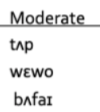CSD 453 Final
1/205
Earn XP
Description and Tags
Name | Mastery | Learn | Test | Matching | Spaced |
|---|
No study sessions yet.
206 Terms
bilabial, labiodental, linguadental, alveolar, palatal, velar, glottal
stop, fricative, affricate, nasals, liquids, glides
voiced: voice is on
voiceless: voice is off
what are the bilabial consonants?
what are the labiodental consonants?
PLACE
what are the linguadental/interdental consonants?
θ, ð
what are the alveolar consonants?
PLACE
what are the palatal consonants?
y, r, ʃ, ʒ, tʃ, dʒ
PLACE
what are the velar consonants?
k, g, ŋ
what are the glottal consonants?
p,b
t, d
k, g
what is a fricative and what are the fricative consonants?
continuous sound through narrow constriction
f, v
θ, ð
s, z
ʃ, ʒ
h
what is a affricate and what are the affricate consonants?
plosive with a fricative sharing same place
tʃ, dʒ
m, n, ŋ
w, y
l, r
manner: stop, fricative, etc.
voiced vs voiceless
what is this sound: θ?
voiceless th sound
fricative, linguadental
what is this sound: ð?
voiced th sound
fricative, linguadental
what is this sound: ʒ?
voiced palatal fricative
beige, vision, measure
by about age 3
substitution processes
assimilation processes
includes disorders in articulation, fluency and voice
about 25% of 11 to 17 year olds with a communication disorder have SSD only
slightly higher in boys
includes articulation (motor) and phonological (linguistic) disorders
not an issue of execution, planning, sensory or structural issues
motor/neurological (execution and planning), structural, sensory/perceptual (hearing impairment)
perceptual-phonetic mismatch
environment- what they hear in environment impacts how they produce their speech sounds
psychosocial/temperament- something related to personality
receptive deficits- something related to how they are receiving and understanding speech
family history (sibling or parents with history of therapy of SSD)
pre- and perinatal problems
low maternal education
low SES
prolonged otitis media with effusion
sensorineural loss
decreased sensory input can affect speech
what are two types of motor issues from an organic perspective of a speech sound disorder?
issue with motor execution: dysarthria
slow, slurred, labored speech, weak or spastic muscles
issue with motor planning: apraxia
higher level brain function issue, searching for correct placement of articulators, distortions
usually just one speech sound
teeth, tongue, VF, hard/soft palate, alveolar ridge
changing this would change the meaning of a word
define phonetic
speech sounds and how they are produced
define phonemic
way in which sounds function in a language
pan for fan
/p/ is not in phonemic inventory
planning and sequencing of motor movements
second step in articulation
first step in articulation
totality of motor processes involving in planning and execution of speech
motor, physical event, phonetic, physiology
requires respiration and phonation
does not change the meaning of a word
dog/dot, white/write, eat/ear
fa**ts**
h**at**
b**ee**
almost like a vowel but has more closure
harmony process
pop/posh, chop/mop
type of intervention
pat/bat, bend/mend
type of intervention
pit → pip, coat → kok
chip → pip, dog → gog
in phonological disorders
phonological disorder
articulation disorder
lateralized /l/ for lion
phoneme collapse: use sounds they have for all other sounds
target-substitute relationship: pattern to their errors
typical speech errors of their age
most develop typical speech development by age 6 with treatment
atypical phonological pattern
accent/dialect
gender affirming voice
what is the difference between a phonetic and phonemic inventory?
phonetic: assesses articulation- if you can say the sound
phonemic: assess meaning and convey meaning- if you can use the sound correctly
mostly distortions, less often impacts speech intelligibility, relative to child’s age, how the person uses the sound
functional: related to development or learning
know how to use phonemes but don’t know when or where to use them
omissions and substitutions, more often impacts speech intelligibility, error patterns that are not age appropriate, consistency in errors
applies to both phonological and articulation issues
reported as percentage of words understood in speech sample
useful to document needs for therapy and progress in therapy
generally concerned at less than 75%
count words understood and divide by total number of words
not always related to intelligibility
7 year old with 4 SSD errors vs 4 year old with 4 SSD errors
quality of life
number of sound errors
number of error patterns
accuracy of productions
phonological disorders usually more severe because it impacts intelligibility the most

context and familiarity helpful


# CC / # correct + incorrect x 100
consistent errors in imitation, words, conversation
no clearly defined etiology
usually no residual errors with treatment
about 50% preschoolers
consistent
inconsistent
different errors on same target words
12%
students who had history of speech sound errors and they don’t have errors anymore
atypical phonological development compared to peers
substitutions, omissions, deletions
low intelligibility, high frequency of errors
can achieve normal speech production with treatment
otitis media: auditory perceptual processing
developmental psychosocial involvement
distortions, omissions, substitutions
CAS, developmental dysarthria
more likely to have residual errors
typical errors: sibilant /s/ and rhotic /r/ distortions
no language/literacy influence
1% of adolescents and adults
nonmedical, non genetic reason for these errors
treatment wasn’t effective
can be pre, post or intervocalic
help form syllable shape
need vowels